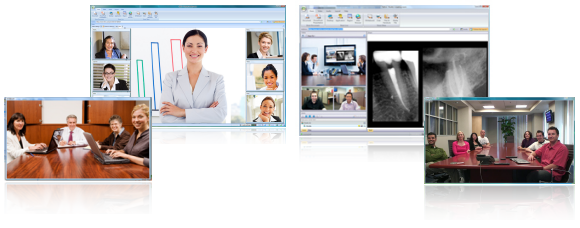
HD Video Conferencing
High definition video conferencing for desktops and multipurpose conference rooms does not
require a large capital outlay or dedicated telepresence studio. With Nefsis, all you need is an HD-capable webcam (720p) or
standard HD pan-tilt-zoom camera, and a computer. It's that easy!
In business-to-business video conferencing, HD is a core component of high-end telepresence offerings. It is also finding its
way into traditional boardroom systems, and — this is the interesting part — now available
in desktop video conferencing software and online services too. In short, a good solution is high definition ready,
boardroom to desktop, using widely available and cost-effective HD computer peripherals.
For most suppliers of video conferencing equipment, high definition requires a platform that is capable of encoding and
decoding the HD video conferencing stream. Vendors such as
Polycom developed a new line of codecs with greater processing power in order to support HD. In the case of Nefsis, the
ability to encode and decode HD video was simply a matter of the peripheral environment (camera and bandwidth). The main reason
is that Nefsis was originally designed to handle HD content and other compute intensive applications.
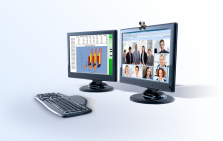 There
was a time when standard PC's lacked the processing power to handle a video conference. Companies, such as Polycom,
Tandberg and Lifesize emerged with dedicated hardware or "box" solutions. This approach was the paradigm for video
conferencing for the past two decades. When HD standards began to materialize, box vendors set about on new custom hardware
designs to handle the additional load associated with HD content. Thus, perpetuating the cycle of dedicated boxes for each
technological advancement.
There
was a time when standard PC's lacked the processing power to handle a video conference. Companies, such as Polycom,
Tandberg and Lifesize emerged with dedicated hardware or "box" solutions. This approach was the paradigm for video
conferencing for the past two decades. When HD standards began to materialize, box vendors set about on new custom hardware
designs to handle the additional load associated with HD content. Thus, perpetuating the cycle of dedicated boxes for each
technological advancement.
But times have changed, the PC's of today are powered by multi-core processors. Think of it as multiple processors on a
single chip. Instead of a single processing core, there are now multiple cores working in unison to deliver a new standard of
performance and power to the desktop.
Furthermore, digital video has permeated the consumer electronics and desktop computing industries. In addition to their
multi-core capabilities, a typical desktop computer sold within the last four years also features extremely powerful video and
multimedia processor extensions such as Intel® MMX and SSE. Indeed, the PC has become a common platform
for watching HD movies, clips and films, dramatic proof that the PC is many times more powerful than box solutions of the past
decade.
Nefsis is the only multipoint video
conferencing application that was designed specifically to take full advantage of multi-core processors and MMX extensions
on a PC. This is one of the reasons why our solution can effortlessly encode and decode multipoint HD content.
The following background information on HD should help you gain a better understanding of the components that make up a
complete high definition solution.
What is HD?
It is a variation of the term high definition television, also referred to as HDTV. Current HDTV standards are defined by the
International Telecommunication Union (ITU) in terms of screen resolution, frame rate, and audio format.
| |

Technical definition: The current standard is 720 progressive scan lines (720p) at 60 frames per second, or 1080
interlaced encoding (1080i) at 50 fields (25 frames) per second, and 16:9 aspect ratio. The current audio format is Dolby
Digital AC-3, also known as v5.1. Standards evolve and the ITU is already laying the groundwork for even higher quality
1080p50 and 1080p60. In the consumer world, HD refers to video cameras, broadcasts, televisions and so on that meet these
ITU specifications. Or more loosely to anything — cinematic film, movies, trailers, shorts, streaming media, Windows
media and photographs — capable of such sharp display or better.
|
In the context of business-to-business (B2B) video conferencing, the term HD generally refers to 720p or better. In
boardroom systems, the audio component is often vague since most of the time only human voice is relevant, unlike consumer
applications where sound and music are obviously very important in movies and broadcast TV.
Indeed, many business conferencing systems specifically filter out anything too high or too low to be human voice, this
includes background traffic, air conditioners, PC fans, etc. Notable exceptions are HD tele-presence studios such as HP Halo,
Cisco Telepresence, Tandberg Experia and others, which adhere to the complete HDTV specification and encode the full
human-audible frequency spectrum and use physically rebuilt conference rooms to achieve high spatial quality and a "fully
immersive" conferencing experience.
Most Standard Computer Monitors are HD or Better
While the consumer and broadcast TV industries migrate from analog to digital video, back at the office computer graphic
displays have been digital all along, and most desktops are already at high definition standards or better.
More specifically, PC monitors at WXGA (1280 x 800) and SXGA (1280x1024) already exceed HD 720p specifications; and WUXGA
(1290x1200) or better monitors are a superset of HD 1080i in both horizontal and vertical dimensions. In other words, a WUXGA
monitor can display HD video and still have room left over to display the system tray and perhaps other application controls.
For comparison charts, click computer display
standards and common resolutions.
Most likely, you already have a 720p or better high-definition monitor right on your desktop and you can certainly buy a
high-quality, flat panel display for your conference room. But what about HD video capture and transmission?
Transmission Quality
Today, virtually all business video communication is digital via TCP/IP-based networks and the public Internet. The only
major variables are connection quality (bandwidth, latency, internal QoS, etc.) and whether or not Internet access goes over
a shared or dedicated route. Of course,
telepresence studios use dedicated routes, usually DS-3
(44 mbits/second) or better, at each site, and often with strict quality of service agreements in place.
Conference rooms, once strictly the domain of dedicated routes, are increasingly using a mix of dedicated and shared
network connections. In particular, small- to medium-sized businesses usually opt for shared connections as the expense and
idle-time of dedicated routes do not pencil out. Desktop video conferencing products and services use standard (shared)
network connections.
Cloud Computing & Superior Low-Latency Performance
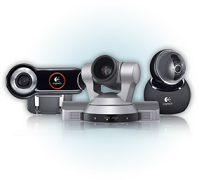 Nefsis was designed to support mixed-speed connections and auto-adjusts video on a per user
basis, achieving excellent results over typical networks. It should be noted Nefsis works perfectly well over dedicated routes
too, at which point the video component can be compared "apples to apples" with pure hardware-based end-points (usually
costing many times the price of Nefsis and PC-based
video peripherals). However, the use of a
cloud computing architecture gives Nefsis users a distinct, low-latency transmission performance advantage over fixed-site,
dedicated hardware solutions.
Nefsis was designed to support mixed-speed connections and auto-adjusts video on a per user
basis, achieving excellent results over typical networks. It should be noted Nefsis works perfectly well over dedicated routes
too, at which point the video component can be compared "apples to apples" with pure hardware-based end-points (usually
costing many times the price of Nefsis and PC-based
video peripherals). However, the use of a
cloud computing architecture gives Nefsis users a distinct, low-latency transmission performance advantage over fixed-site,
dedicated hardware solutions.
Some products claiming to be a 'cloud' are really just a large centralized data center supplying a service, without
any of the benefits of cloud-based service distribution. A true cloud, like Nefsis, offloads and distributes the experience
across the Web.
Nefsis does this by using a massive network of distributed computers to ensure the highest quality video conferencing
experience; minimizing latency while delivering all the benefits of load-balancing, failover, and the scalability that true
cloud architecture provides. Because low latency is so critical in video conferencing, the goal at Nefsis is to provide sub-30ms
response time for every conference participant by expanding our distributed network to the far reaches of the globe.
HD Video Capture
Another dynamic in the conferencing industry is the movement toward PC-based peripherals. Stand-alone audio/visual systems
are increasingly becoming available as peripheral devices for modern PCs. Whether USB or PCI bus, so as long as new peripherals
have device drivers, software vendors such as Nefsis can use these new components via standardized APIs and leverage their
availability, low-cost and consumer-driven HD quality.
For example, let's look at the following devices that are now available worldwide:
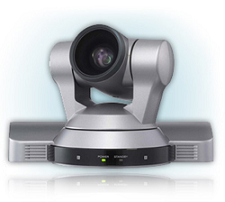 Sony® EVI-HD1
Sony® EVI-HD1
- Effective Pixel Elements: Approximately 2m effective pixels
- Signal System: 1080/59.94i, 1080/50i, 1080/29.97p, 1080/25p, 720/59.94p, 720/50p, 720/29.97p, 720/25p, NTSC, PAL
Sony EVI cameras are a popular choice for conference room applications. The EVI-D70 has a large installed base, and it is
commonly used with Nefsis for full-screen (640x0480), full motion (30 fps) video conferencing. The HD1 is an exciting new
addition to the Sony product line with true HD capabilities. High definition is by no means cheap, at roughly $4,000 street
price, the HD1 is four times the cost of the D70, which is widely available for roughly $1,000 (USD).
To use the newer HD1 at high definition quality levels requires a PCI bus video capture card that supports HD signaling
and frame rates, plus an available DirectX device driver. At the present time, Nefsis is aware of several new capture cards
that meet these requirements, and are actively testing new cards as they become available. Please
contact us for details.
Logitech® USB Cameras
Logitech Quickcam® Ultra Vision™
- Sensor: True 1.3 megapixel sensor with RightLight™ 2 Technology
- Live video: up to 640 x 480 pixels up to 30 frames per second
- Still image capture: True 1280 x 960; Up to 4 megapixels
Logitech Quickcam Pro™ 9000
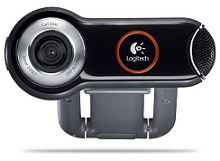
- Sensor: True 1.3 megapixel sensor with RightLight™ 2 Technology
- Carl Zeiss® lens
- Autofocus system
- Ultra-high resolution 2-megapixel sensor with RightLight 2 Technology
- Color depth: 24-bit true color
- Video capture: Up to 1600 x 1200 pixels (HD Video 960 x 720 pixels)
- Frame rate: Up to 30 frames per second
- Still image capture: 8 million pixels (with software enhancement)
- Built-in microphone with RightSound Technology
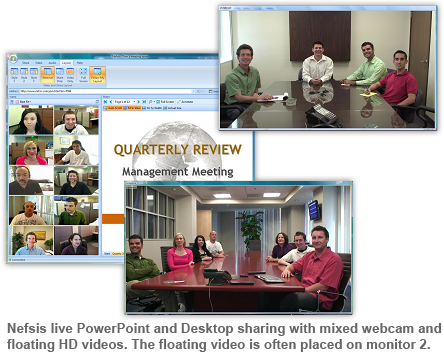
The new Logitech Quickcam 9000 USB webcam produces stunning video quality for a desktop device, it is better than broadcast
TV and squarely in enhanced definition territory. The Sony HD1 conference room camera is a true high definition device, and it
works beautifully with the first 720p capable video capture card tested with Nefsis software.
The trend is clear: between Logitech, Sony, and the industry at large, consumer-driven HD technology will
soon find its way into widely available PC-based video
conferencing equipment at far more affordable pricing than previous generations of boardroom systems and current HD
end-points.
As these PC peripherals become available, they can be used by advanced software and online services such as Nefsis for HD
video conferencing between boardrooms, conference rooms and desktops without locking customers into proprietary systems.
Summary Chart
This PDF chart shows Nefsis compatible USB and HD video conferencing devices, their input formats and bandwidth required to
run at full frame-rates: HD
& USB video inputs & bandwidth.
See For Yourself — Schedule a Live Demo Right Now!
Click here to schedule a live demo and see Nefsis HD video conferencing for
yourself, right from your own desktop, when most convenient for you.
 We
can easily demonstrate the Logitech Ultra Vision, Fusion, 9000, Sony D70, HD1, and other devices all with desktop sharing, live
collaboration and multiple participants.
We
can easily demonstrate the Logitech Ultra Vision, Fusion, 9000, Sony D70, HD1, and other devices all with desktop sharing, live
collaboration and multiple participants.
 You might be surprised by how easy it is to take advantage of the latest video peripherals to enhance your online meetings,
presentations and training.
You might be surprised by how easy it is to take advantage of the latest video peripherals to enhance your online meetings,
presentations and training.
Nefsis is a registered trademark of Nefsis Corporation.Sony is a registered trademark of Sony Electronics,
Inc. Logitech and QuickCam are registered trademarks of Logitech.
All other trademarks are property of their respective owners.